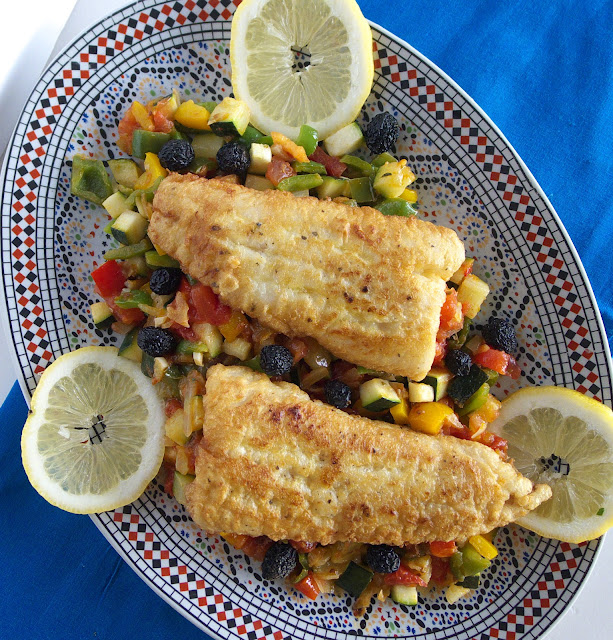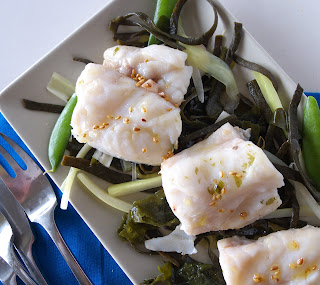A local fish vendor, in a good marketing move, started offering fish en filetes, filleted and ready to cook. Up until then, I had to buy a whole fish, then ask him/her to fillet it for me. Sometimes, if I wasn’t sure if I wanted to cook the fish whole, I wound up doing the job myself.
Now I could avail myself of fillets of mackerel, sea bass and gallineta, a particularly tasty rock fish. Here are some of the ways I found to cook fillets—pan fried, steamed, broiled and poached.
Pan Fried
 |
| Fillets cut from the tail of a whole hake are lightly breaded and pan fried. Served on a bed of pisto, a vegetable mélange that serves as side and sauce. |
Steamed
Broiled
 |
| Fillets of sea bass broiled on a sheet pan with asparagus. |
Poached
 |
| Delicate sole fillets are wrapped around thinly sliced ham and poached in simmering fish stock, served with a creamy sauce with mushrooms and shrimp. |
Pan-Fried Hake Fillets with Pisto
Merluza Rebozada con Pisto
Pisto—not to be confused with pesto—is a vegetable melange that serves as both side dish and sauce for the fish.
I bought a whole hake and had the fish vendor fillet it. I used the tail fillets for this fried fish and saved the lomo, or center section, for the steamed fish recipe. This method of breading the fish—dipping it first in flour and then in beaten egg—is especially good for delicate fish such as hake. It works well with cod or sole too. It’s good, too, for firm-fleshed fish, such as pargo and urta, two kinds of bream, that are first fried, then finish cooking in a sauce. The egg coating protects the fish so that it doesn't fall apart. Season the flour with any dried herb—oregano, thyme, garlic powder. Flour the fish and dip it in egg immediately before frying.
For the pisto
2 tablespoons olive oil
½ cup chopped onion
1 cup chopped green pepper
½ cup chopped red and yellow bell pepper
1 ½ cups diced zucchini
1 clove garlic, chopped
1 cup peeled and diced tomato
Salt
Freshly ground black pepper
Oregano
Red pepper flakes (optional)
Black olives to garnish
Heat oil in a skillet and add the onion and peppers. Sauté, stirring, until onions are softened, 5 minutes. Add the zucchini, garlic and tomatoes. Season with salt, pepper, oregano and red pepper flakes, if using. Cook until tomatoes release their juices and zucchini is just tender, 5 minutes. Serve the pisto garnished with black olives.
To pan-fry the fish
Fish fillets, 5-6 ounces each
Salt
Freshly ground black pepper
Flour
Seasoning for flour, as desired
Beaten eggs(s)
Olive oil for frying
Pisto, to serve
Pat fillets dry with paper towels. Season them with salt and pepper. Place flour, seasoned, if desired, in a shallow bowl. Place beaten egg in another shallow bowl.
 |
| Dredge fish fillets first in flour, then dip in beaten egg before frying in olive oil. |
Place oil in a skillet to a depth of ½ inch and place on moderately high heat. Dredge fillets first in flour, covering them thoroughly. Pat off excess flour. Dip the floured fillets in the egg, coating them completely. Fry them in hot oil until golden. Turn and fry the reverse side.
 |
| Drain the fish on paper towels. |
 |
| Serve the fillets on a bed of pisto. |
Hake Steamed with Seaweed
Merluza al Vapor con Alga
Steaming is such a good way to cook delicate fish such as hake. This recipe, which uses several kinds of seaweed (alga) to flavor the fish, is adapted from Cocina con Algas, published by Portomuiños, producers of seaweed products in Galicia (northwest Spain). I´ve added garlic and pimentón to the finished dish. The recipe called for four kinds of seaweed—kombu (sugar kelp), wakame, sea spaghetti and musgo de Irlanda, Irish moss, which I did not have. (More about cooking with algae here.)
Use a bamboo steamer or a vegetable steamer basket, if you have one. If not, improvise. A Moroccan cous cous steamer. Heatproof metal colander. Metal cake rack. An inverted pie pan with a heatproof plate on top. The steamer needs to fit inside a deep skillet or wok with a lid. Add enough water to the skillet to reach just below the level of the steamer rack.
Arrange the fish on top of the seaweed in a single layer. If you have more servings than will fit, do a second steaming. Vegetables such as asparagus tips or sugar snap peas can be steamed with the fish.
 |
| Wakame, sea spaghetti and kombu. |
Serves 2.
4 (3-ounce) pieces of hake fillet with skin
Salt
2 to 4 kinds of dried seaweed, such as kombu, wakame, sea spaghetti and Irish moss (about 1 ounce total)
3-inch piece of leek
¼ cup extra virgin olive oil
1 dried chile
1 clove garlic, crushed
½ teaspoon sesame seeds
¼ teaspoon pimentón de la Vera (smoked paprika)
Asparagus tips or sugar snap peas
Salt the pieces of fish and let them come to room temperature.
Rehydrate each of the kinds of seaweed by soaking them in cold water for 10 minutes. Drain well. Cut large pieces into strips. Separate strands of sea spaghetti. Place all of the seaweed in the steamer. Cut the piece of leek into lengthwise strands and mix them with the seaweed.
 |
| Steam fish on a layer of seaweed. |
Heat the oil in a small skillet with the chile and garlic until garlic begins to turn golden. Remove from heat and add the sesame seeds. (Cover the pan to prevent the sesame from popping out.) Remove cover and stir in the pimentón and ¼ teaspoon of salt. Remove chile and garlic. Keep sauce warm.
Arrange the pieces of fish, skin-side up, on top of the layer of seaweed. Tuck asparagus or peas around the fish. Bring the water in the steamer pan or skillet to a boil. Place the steamer over the water, reduce heat so the water boils gently and cover the pan tightly. Steam the fish until it just flakes when prodded with a skewer, about 5 minutes for the 3-ounce pieces.
 |
| Steamed fish is moist. |
Broiled Fillets of Sea Bass
Filetes de Lubina al Grill (Gratinador)
A topping of seasoned mayonnaise keeps the fillets moist under the broiler heat. The crumbs give a final crispness. You’ll only need about a teaspoon of the mayo for each fillet. Use the rest to serve alongside as a sauce.
I used fillets of sea bass (lubina), but gilthead (dorada), scorpionfish (gallineta) or other firm-fleshed white fish would work well. Thicker salmon fillets can be broiled using the same method. The fish is done when browned on top. Timing depends on the thickness of the fillets. Thin sea bass fillets needed only about 4 minutes (6 inches from the heat source). For thick fillets, increase the distance between the pan and the heating element. (The British and Spanish call a broiler a “grill.”)
Fish fillets, 5-6 ounces each
Salt
Freshly ground black pepper
Olive oil
¼ cup mayonnaise
1 clove garlic, crushed
Chopped parsley
1 tablespoon fresh lemon juice
¼ cup fine dry bread crumbs
½ teaspoon pimentón de la Vera (smoked paprika)
Sprinkle fillets with salt and pepper. In a small bowl whisk the mayonnaise with the garlic, parsley and lemon juice.
 |
| Spread fish with mayonnaise and crumbs before broiling. |
Preheat broiler to maximum. Arrange the fillets on a broiler pan or sheet pan that has been lightly brushed with olive oil. Spread about 1 teaspoon of mayonnaise on top of each fillet. Combine the bread crumbs and pimenton. Sprinkle 1-2 teaspoons of crumbs on top of each fillet.
Place the pan about 6 inches under the heating element. Broil until the top of the fish is browned.
 |
| Broil asparagus and par-boiled potatoes on a sheet pan alongside the fish. |
Fillets of Sole with Ham and Mushroom Sauce
Filetes de Lenguado con Jamón y Salsa de Champiñones
The sole fillets are folded around thinly sliced ham, then poached in fish stock. Make the sauce separately and reheat it once the fish is ready to serve. This recipe would be equally good made with other flat fish such as turbot (rodaballo), flounder (gallo) or John Dory (pez de san pedro). Depending on how the fish is filleted, you may have two or four fillets from one fish.
Use store-bought fish stock for the poaching and sauce. Or make a quick stock by cooking head, bones and trimmings in water with leek, kombu (seaweed), lemon and salt. (You can also cook potatoes or rice in the stock to serve with the fish.)
Serves 2.
8 (1 ½-ounce) fillets of sole (from 2 fish)
Salt
1 ½ ounces thinly sliced ibérico or serrano ham
Fish stock for poaching the fish
For the sauce:
2 tablespoons olive oil
2 shallots, finely chopped
½ cup finely chopped mushrooms
¼ cup dry white wine
½ cup fish stock
1/3 cup cream
Salt
Freshly ground black pepper
¼ cup chopped cooked shrimp
Finely chopped parsley
 |
| Fold fillets around sliced ham. |
Spread the fillets out flat. Sprinkle them with salt. Top each fillet with strips of ham. Fold the fillets over the ham into thirds. Cut strips of foil 2 inches wide. Wrap the bands like a belt around the center of the folded fillets. Pinch the ends of the foil together to prevent the fillets from unrolling.
Choose a pan or skillet just large enough to hold the fish in one layer. Add stock to a depth to cover the rolled fillets. Bring it to a boil, reduce heat and carefully place the fish in the poaching liquid. Simmer, covered, until the fish just flakes, 4 to 5 minutes. Remove the fish with a slotted spoon to a heated platter.
For the mushroom sauce:
Heat the oil in a saucepan or small skillet and sauté the shallots and mushrooms until softened, but not browned, 5 minutes. Add the wine and cook off the alcohol, 2 minutes. Add the fish stock and cook 10 minutes. Add the cream and cook until the sauce is reduced and beginning to thicken, 5 minutes. Season with salt and pepper. Stir in the chopped shrimp and heat.
Serve the sauce with the fish. Sprinkle with parsley.
More recipes for fish fillets:


So thrilled to read your post - here in eastern coastal Australia I am certainly trying to make fish my 'protein' more often ! All your recipes add to my fish cookery knowledge but I am most interested in steaming and grilling !!! Here we have a tendency to steam whole with lemongrass, ginger etc in the Asian style . . . so I have already had a productive conversation with Mr Google as to which seaweeds I can access here in the country, the fresh not a;ways being available . . . no problems ! And the whole lesson has already gone onto the recipe pile in the kitchen !!!
ReplyDeleteI'm totally sold on all of those! I particulalry like merluza and often find it fresh and reasonably cheap in the Boqueria. Talking of which, the fish ladies start filleting and cleaning fish on quiet afternoons and you can pick up a bargain, ready to cook.
ReplyDelete